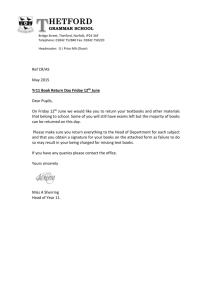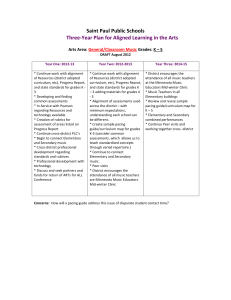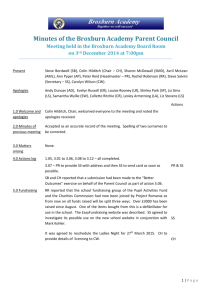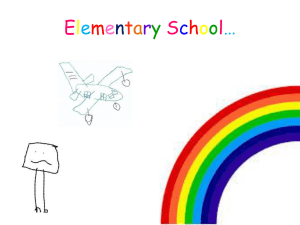Area: Academics
advertisement
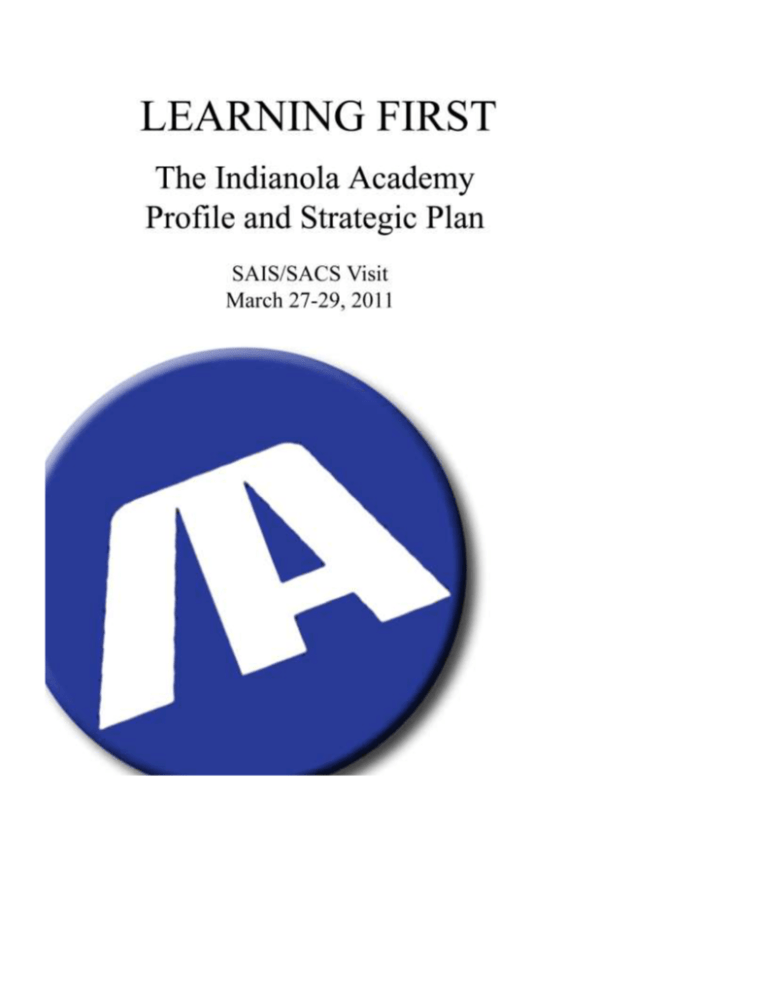
PROFILE OF THE INDIANOLAACADEMY INTRODUCTION: This profile is a presentation of data collected from many areas and used to create a summary of student performance, student and community demographics, and characteristics of the school, and to produce various charts and narratives. The strategic plan was a product of extensive data gathering from various stakeholders and intense study and research by various committees. IA is placing recommendations in action, and has set ambitious goals for the students, faculty, and school. “Learning First” has been the school improvement motto for several years, and it continues to be the ultimate goal of this strategic plan. This motto is in the mission statement and is the scale used to measure every decision made at The Indianola Academy. The design of this plan and profile is to stimulate school improvement. This task is never complete and is subject to constant change. Committees will continue to monitor trends and to provide updated information to the board of directors each year. THE SCHOOL: The IndianolaAcademy is a PreK-12 private school located in the Mississippi Delta within the city limits of Indianola in SunflowerCounty. The IndianolaAcademy is accredited by the Mississippi Association of Independent Schools, Southern Association of Colleges and Schools, and the Southern Association of Independent Schools. The IndianolaAcademy is a non-discriminatory 501-C3 non-profit institution which accepts private donations and tuition receipts to operate the school. An endowment fund is and has been in place to ensure the financial security of the school and plant. The board of directors strives to keep tuition affordable and acts as a careful steward of all money received. The IndianolaAcademy provides an alternative to public schools for parents and students capable of meeting the academic and financial requirements. A committee selected by the school oversees a minority scholarship fund dedicated to assisting minority students. (Income and Disbursement Chart) Students living in Indianola make up 58.3% of the current enrollment. This number was 70.6% in 2006. Students from Invernessmake up 16.7% of the current enrollment, a number up from 6.19% in 2006. The percentage of students from Moorhead is 6.2% and is up from 4.2% in 2006. The changes in enrollment percentages for Inverness and Moorhead are a result of the closing of CentralDeltaAcademy, a K-6 school that was located in Inverness. Students from Sunflower make up 4.7% of our students. This percentage is down from 8.2% in 2006. Enrollment from other cities includes Isola 2.8%, Shaw 2.1%, Leland 1.9%, Belzoni 1.7%, and Doddsville 1.3%. The remaining 4.3% comes from cities further away where no city represents more than 1% of the total. (Demographics of Students by City of Residence Chart) In the Mississippi Delta, farming and farm related companies are the key components of the economy. Many of the parents of IndianolaAcademy students own farms, and some derive income from working for large private farms. Farm related industries, which are large employers of our citizens and some IA parents, include Delta Western (catfish feed production), Delta Pride (catfish processing), Bell Manufacturing (production of farm tools and implements), and Wade Incorporated (sale and repair of farm equipment). There are several cotton gins in the area, but due to the decrease in cotton production that began in 2008 only the Holly Ridge Gin is currently in operation. In recent years economic stress on the farming industry has caused a tightening effect on all industries in the area. The catfish industry has seen many farms stop production, and as a result some IA parents have lost employment. As in the US economy, jobs in the delta which pay at a high enough wage to allow their employees to choose private schools have become harder to find. Over the past seven to ten years many residents have moved out of our area to seek better employment opportunities. Many cities in the delta area have seen a large fall in population due to economic changes. The prominent non-farm related companies in the area are Dollar General, the largest, Lewis Grocery, Gresham Petroleum/Double Quick, SouthSunflowerCountyHospital, and several educational institutions. Dollar General and Lewis Grocery are distribution centers in which the majority of jobs offered pay a wage which is not sufficient to pay private school tuition. Gresham Petroleum/Double Quick provides jobs at all pay levels and employs many parents of IA students. SouthSunflowerCountyHospital provides jobs to many IA parents who are in the medical field. Indianola and the surrounding areas are also serviced by home health companies who employ parents. MississippiDeltaCommunity College, Delta State University, Mississippi Valley State University, IndianolaPublic Schools, and SunflowerCountySchools are educational institutions that provide employment for a number of IA parents and patrons. State, county, and local government agencies also provide many jobs in our area and are employers of some of our parents. Other parents whose students attend The Indianola Academy are merchants and bankers or are in service related businesses. The IndianolaAcademy is one of several private schools in the area. NorthSunflowerAcademy is a PreK-12 school located thirty minutes north in Drew. Other schools located in a thirty mile radius are BayouAcademy and PresbyterianDay School (both in Cleveland), HumphreysAcademy (Belzoni), Greenville Christian and WashingtonSchool (both located in Greenville), and PillowAcademy (Greenwood). PillowAcademy and WashingtonSchoolhave a larger enrollment than IA. The other schools listed have a smaller enrollment than IA. Competition for students is, for the most part, evident only in the geographical areas between schools, but with the small driving distance, students have alternatives to attend other private schools. THE PAST AND THE PRESENT: The IndianolaAcademy began its first session in the fall of 1965 with seventy students in first and second grades. Classes were held in the First Baptist Church of Indianola. In 1966, one hundred eighty students in grades one through seven met at First Baptist and First United Methodist in Indianola. In 1967, two hundred forty-one students in grades one through nine met at the same churches. In 1968, two hundred eighty students in grades one through ten attended the new building on Dorsett Drive. The 1969 session began with six hundred students and expanded to fifteen hundred for the second semester. Some students returned to the churches and others moved to additional buildings that had been provided. In the 1970 session the high school and junior high students attended the Dorsett Drive location, while the elementary continued to meet in the churches. The enrollment in grades one through twelve was 1500students,and IA awarded diplomas to its first graduating seniors. In 1971 The Indianola Academy received accreditation from the Mississippi Private School Association and the State of Mississippi, and both elementary and secondary students attended the educational plant on Dorsett Drive. In 1977 the IndianolaAcademy’s eighth graduating class included twenty students who had attended IA for their entire twelve years. In the decade of the 70s the private schools built in the towns around Indianola caused a reduction in IA’s enrollment as students transferred to schools closer to their homes. In 1980 The Indianola Academy became a member of the Southern Association of Colleges and Schools. A gradual decrease in enrollment started in the middle to late eighties and continued through the 2004 session due to the reduction of job opportunities and farming difficulties. The 2005 session began with the first significant increase in many years, and a growth trend has continued that to date finds our school enrollment up over 100 students from our last SACS visit. The 2010-2011 year has seen a significant enrollment increase due to the closing of CentralDeltaAcademy last spring. (Enrollment Chart) The educational plant consists of twenty acres of land housing a lower elementary building, upper elementary/middle school building, high school building, science building, gymnasium/auditorium, music building, storage building, baseball field, soccer field, softball field, and elementary playgrounds. The high school building contains a library, cafeteria, multipurpose room, computer lab, dressing and newly renovated boys’ weight room, and other facilities. The Gym has dressing facilities, girls’ weight room, stage, and other facilities. The upper elementary/middle school houses a library, two art rooms, an elementary science lab, computer lab, and other facilities. The lower elementary building contains a computer lab and other facilities. The school also owns a football stadium, concession stand, football field house, practice field and track facilities. The stadium complex is located 2 blocks south of Highway 82, three minutes from the campus. Members of The Indianola Academy faculty have been called from local areas, and many have chosen to serve for many years. IA teachers have been loyal to the school and dedicated to the parents. They are responsible for a great deal of success and consistency throughout the years. Several have retired with twenty-five or more years of service to IA, and others remain working with decades of service to IA. (Teacher Information Chart) Administrators have also had long terms of service at IA, providing consistent leadership and guidance. The IndianolaAcademy has had seven headmasters in forty-six years, the first serving two years, the second serving four years, the third serving eight years, the fourth serving nine years, the fifth serving thirteen years, the sixth serving six years; our current headmaster is in his fourth year. (Administrator Information Chart) Recent statewide and area teacher shortages and competition for top educators have caused IA to look outside the local area for quality teachers and administrators. Main competitors for educators are the public schools, who have seen reduction in their faculties, other private schools, and MississippiDeltaCommunity College. Recruiting and retaining quality teachers is one of the most important challenges facing The Indianola Academy. The IndianolaAcademy enjoys a history of outstanding support by the local community. The community and its leadership understand and appreciate the role of The Indianola Academy and support IA in every way. This support is vital to the success of the school, and IA makes every attempt to maintain and strengthen its relationships and reputation in the community. Graduates of The Indianola Academy have attended colleges and universities throughout the state and nation. The performance of IA graduates at the college level has been outstanding through the years and is a result of a quality instructional and testing program and dedicated parents, students, and teachers. Over the past five years 96.18% of IA’s graduates have attended a college or university, 1.91% enlisted in military service, and 1.91% entered the work force. Some attend four year schools, and others begin at a community college. MississippiDeltaCommunity College is located ten miles east of Indianola, and many IA graduates choose MDCC because of its tradition, location, and cost. Surveys and contacts with graduates show they are successful in college and are satisfied with the instruction given to them at The Indianola Academy. In college readiness testing IA students perform consistently above the local and state averages, and at or above the national average on the ACT, PLAN, EXPLORE, and achievement tests. These tests serve as a tool to oversee the instructional program and to ensure the continued outstanding performance of graduates. (ACT, PLAN, EXPLORE, and Achievement Test Charts) The IndianolaAcademy has worked very hard to stay on the cutting edge of educational technology and has a reputation as an innovative and progressive institution. It has adopted and implemented updates in technology. At the present time the school has two computer labs with around fifty machines. The lab in the upper elementary/middle school building serves as a resource and instructional aid for elementary and middle school students. The other, located in the high school building, is used for instruction in computer literacy and application for middle school and high school students. A point of emphasis in the 2005 strategic plan was to enlarge access to computers for our faculty and students. By 2008 computers with internet access were available in every classroom. In 2008 the internet based STI software for grades, attendance, and scheduling was added to help faculty and to give access to grades, plans, attendance, and discipline to our parents. At the end of the 2010-2011 school year we will replace the labs with new computers and update our classroom computers. Every teacher has an email address assigned by the school and published to parents. School offices areequipped with the STI program and oversee its implementation. The Indianola Academy Web Site, prepared and updated by IA students, provides important information about all programs and areas of the school. Our web page provides a link to the STI program. This year we placed our student handbook on line making access more convenient for our parents and students. Our strategic plan, profile, and other materials are always available on our school web site. Internet access is available in the computer labs, library, and science building for research and exploration. IA will continue to incorporate the latest technological improvements. The IndianolaAcademy offers a full range of extra-curricular activities. Involvement in these activities adds a great deal to the enjoyment and learning of the students. IA constantly seeks new and innovative ways to involve students in areas which will showcase and develop their talent. In an ongoing quest to make each student a part of the extra-curricular programs, IA gathers and implements student and faculty opinions on sports, activities, and organizations. THE COMMUNITY: Indianola, Mississippi, is a town with a population of around 11,000. The population of Indianola has fallen around 10.45% since the 2000 census. A trend in decreasing population exists in a very similar way in all the towns our students live in with the exception of the town of Sunflower which has experienced an increase in population. The population of SunflowerCounty is around 31,000 a decrease from 35,000 in the 2000 census. The racial mix of the county is reported as 72.8% Black, 26.1% White, and the remaining 1.1% a mixture of ethnic groups. The population of the Hispanic ethnic group, though still a small percentage of the total, has grown consistently in recent years. The median household income of SunflowerCounty is reported at $28,266 per year. Around 36 percent of the population lives below the poverty level. The median income reported byIndianolaAcademy families is $71,000-$80,000 (Income Level of IA Families Chart). The average educational level of parents of IndianolaAcademy students is significantly higher than that of the average SunflowerCounty resident over age 25. 96% of Indianola Academy parents hold high school diplomas, 71% hold at least an Associate Degree, 57% hold at least a Bachelors Degree, 19% hold at least a Master’s Degree, and 5% have a least a Doctoral Degree. 60% of SunflowerCounty residents over 25 have high school diplomas, and 12% have a bachelor’s degree or higher.(Education level of parents of IA students) SunflowerCounty, Indianola, and The Indianola Academy are made up of people of many different faiths. Baptist, Methodist, Presbyterian, Episcopal, Catholic, Jewish, and other faiths make our community diverse. THE FUTURE: The strategic plan project originally began in 2005 with the idea of where IA should be in five years. The effort was successful, and now we look ahead to the next five years. Long term planning is not simple and requires the use of many people from inside and outside the school. IA brought time and energy to the questions and collected data through surveys, meetings, and analysis of existing programs. Every step taken aligned with the “Learning First” vision mentioned in the mission statement and the beliefs of The Indianola Academy. Throughout the process a number of people from all areas of the school community and community at large participated in the discussion to ensure the plan met the needs of our students. Many of the proposed improvements have been implemented, and many more are moving towards implementation. The plan has revealed a vision of a better IndianolaAcademy. Each step taken in the implementation will bring IA closer to providing better opportunities for the most important stakeholder we have – each individual student. Self Study Narrative As the process for self study began, IA selected a steering committee to complete the task. Members of this committee represent all stakeholder groups. Some members served on the 2005 plan and brought to this committee experience in the self improvement process. Upon completing the profile of IA our steering committee reviewed all the data collected and set out to create a survey which would give us information from our stakeholders in areas likely to need improvement over the next five years. This work resulted in the creation of a survey instrument that would consist of open ended questions asking our stakeholders for their opinions and input and other questions that would allow our stakeholders to rate IA’s performance in an area on a scale of 1 (strongly disagree) through 5 (strongly agree). Members of the steering committee implemented the surveys and gained input from all stakeholder groups. The surveys were then scored and the scores averaged on the objective questions. Results of this part of the survey are available in the attached chart and graph. The chart shows the average score on each question for each group and for all groups. The graph shows the average total score by group and by all groups. The steering committee carefully studied these responses and discussed areas which were successful and areas which the stakeholders felt IA needed to review. The subjective responses were listed by question and sub-question. The opinions gathered from our stakeholders in this part of the survey were candid and allowed for comments and explanation. The responses allowed the steering committee to feel the passion and urgency expressed by the stakeholders and resulted in a great deal of review and discussion in the steering committee meetings. The steering committee carefully reviewed the profile, the scores on the rated survey questions, and the opinions expressed in the open ended survey questions and identified academics, student involvement, communication, and facilities as the four areas of emphasis for the five year strategic plan. The steering committee then authored vision statements designed to express what IA should strive to achieve in each area. The steering committee assigned these areas of emphasis to subcommittees who wrote goals based on the steering committee’s vision statements and created action plans to accomplish those goals. A list of committees and committee members appears in attached documents. The steering committee then reviewed the goals and action plans from each area committee and after serious discussion and debate selected the plans best aligned with our stated vision and beliefs for implementation in our five-year plan. The steering committee will hold for consideration those not selected for the plan and will review them periodically for possible implementation as the plan matures. The steering committee then set about the task of implementation of the plan including assigning responsibilities and time lines. The committee will oversee the implementation and review of this plan for the next five years. STRATEGIC PLAN STEERING COMMITTEE: Charles Mason, Chair Lou Adams Susan Allen Melinda Andrus Cindy Baird Bobbie Sue Bowen John Rodgers Brashier Kathy Chism Andy Daniels LynnDelas Megan Kaye Donahoe ReginaGammill Katherine Gibbs Tom Gresham Leigh Hargett Sammy Henderson Barbie King Emily McDaniel Darby Moor Kuykendall Murry Missy Pitts Cameron Richardson Elyette Robertson Mary Nelson Robertson Lisa Sledge Robert Sledge Lynn Varner ACTION TEAM COMMITTEES & SUBCOMMITTEES: COMMUNICATION John Rodgers Brashier, Chair Melinda Andrus Megan Kaye Donahoe Sharon Ervin Leigh Hargett Robin Hobbs Jennifer Horner Debbra Lyon Emily McDaniel Kim Spencer Carol Ann Terrell ACADEMICS Sammy Henderson, Robert Sledge, Co-Chairs Reading Comprehension Recruiting/Retaining Teachers Foreign Language Katherine Gibbs, Chair Lynn Delas Rebecca Henderson Carrie Hodges Elizabeth McCarty Debbie Woodruff, Chair Sara Ann Harris Ruth Carmen Poindexter Lynn Varner Classroom Technology Methods of Instruction and Curriculum Carolyn Ann Sledge, Chair Donna Britt Watson Cook Robin Davis Naomi Makamson, Chair Deborah Domino Jimmy Childers Music and Drama Lisa Sledge, Chair Linda Arant JackiBurkhalter Nanette Long Jennifer Alford, Chair Rebecca Barrier Sara Smith FACILITIES Andy Daniels, Chair Paul Ervin Tommy Nester Clete Putnam Stacy Wilson Cameron Richardson STUDENT ACTIVITIES Elyette Robertson, Chair Lou Adams ReginaGammill Deven Hill Candace Holland Maggie Jones Dana Lipsey Teri Manning Darby Moor Emily Owen Melissa Richardson Mary Nelson Robertson Jessica Simmons Teresa Spealman Valarie Townsend Ed Waldrup Shan Wright MISSION STATEMENT Our Mission is to keep learning first and thus prepare all students to meet the challenges of the future. OUR BELIEFS All students can learn. Student learning should be the chief priority of our school. Each student is a valued individual with unique physical, social, emotional, and intellectual needs. Challenging expectations increase individual student performance. Exceptional students at both high and low levels of ability require special services and resources. The commitment to continuous improvement is imperative if our school is going to enable students to become confident, self-directed, lifelong learners. AREAS OF EMPHASIS AND VISION STATEMENTS COMMUNICATION Important information is available to faculty, students, and parents within the school and is also available to the stakeholders in the community. IA uses all available methods and the latest in technology to keep all stakeholders informed day to day and, in an emergency, moment to moment. ACADEMICS Student learning is paramount at IA. Quality teachers and administrators provide an environment where learning takes place. IA provides students with instruction that prepares them for the challenges of life. IA uses modern methods of instruction and maintains up to date technology to allow students to be competitive in our state and nation for scholarships and college entrance. IA exposes students to opportunities in language, music, and art to ensure that they are well rounded. IA strives to meet the needs of all learners and seeks to inspire them to a lifetime of learning. FACILITIES IA provides a beautiful campus with clean and functional facilities to enhance the learning environment. IA seeks both to maintain current facilities and to look constantly for areas needing improvement. Our academic and athletic facilities are some of the finest in our classification and are a source of pride for our students and community. IA continually inspects its facilities and repairs and improves them in a timely fashion. STUDENT ACTIVITIES IA provides many different opportunities for students to be involved and active. Athletics, music, art, drama, and clubs provide student interaction and a sense of pride in the community. IA’s “Your Place to Shine” attitude leads our school to seek opportunities for students to excel inside and outside the classroom. Area: Communication Goal 1: IA will improve the ability of staff to communicate important or emergency information to an individual room or all rooms. Action Steps Responsible Timeline IA will install a new intercom system in all school buildings. Board Headmaster 2011-2012 IA will train all staff in operation of new intercom system. Headmaster Principals 2011-2012 IA will revise existing emergency policies and procedures involving the use of the intercom to align them with the new system. Headmaster Board Principals 2011-2012 Goal 2: IA will improve the swift and accurate flow of information to all stakeholders. Action Steps Responsible Timeline IA will publish dates, times, and events on STI, the school web page, and the morning report email. Headmaster Principals Administrative Assistants Web Page Sponsor 2011-2015 IA will update address list for the IA Newsletter each year and allow opportunities for stakeholders to subscribe. Newsletter Editor Director of Development 2011-2015 IA will ask all parent organizations to select an officer to inform all school offices of important information on a weekly basis so that IA can publish information to stakeholders. PTO President Booster Club President Administrative Assistants 2011-2015 IA will publicize dates and times when teachers will be available to tutor students during or after school. All Faculty Administrative Assistants 2011-2015 IA will correspond with all stakeholders during summer months and holidays to make them aware of changes in policy or staff as the board directs. Headmaster Principals 2011-2015 Area: Academics (Sub-Area: Music and Drama) Goal 1: IA will augment the current teaching of music to elementary students while creating new music and drama programs for middle and high school students. Action Steps Responsible To enhance student appreciation and understanding of music’s influence on all cultures, IA will incorporate music in elementary history and geography. Subject Area Teachers 2011-2015 Elementary Principal IA will offer high school music classes for academic credit. Music Chair Secondary Principal 2011-2013 IA will offer a school choir that will participate in competitions and perform for interested groups in our area. Music Chair Secondary Principal 2012-2015 IA will present a variety show/drama at least once a year. Music Chair HS Faculty Secondary Principal 2012-2015 Area: Academics Timeline (Sub-Area: Classroom Technology) Goal 1: IA will use technology to help enhance reading in grades K-8 by incorporating technology. Action Steps Responsible Timeline IA will add software to extend the accelerated reading program through grades K-8. Elementary Principal Middle School Principal Elementary Teachers Middle School Principal 2011-2013 IA will provide additional computers in K-8 classrooms for accelerated reading program. Headmaster IT Coordinator 2011-2013 Area: Academics (Sub-Area: Foreign Language) Goal 1:IA will provide a foreign language program in Spanish that is based on state standards, seeks to expose Spanish to young students, and prepares students for success at the college level. Action Steps Responsible Timeline IA will expand Spanish program In elementary. Spanish Chair Elementary Principal 2011-2013 IA will increase student cultural experiences by focusing on Spanish literature, poetry, and art. Spanish Chair Secondary Principal 2011-2015 IA Spanish program will focus on conversation, information exchange, and debate. Spanish Chair Secondary Principal 2011-2015 IA will require students to complete and be tested on at least 2 Spanish novelas. Area: Academics Spanish Chair Secondary Principal 2011-2015 (Sub-Area: Reading Comprehension) Goal 1:Students in grades K-7 will score 75% or more on Total Reading on the Stanford Achievement Test. Action Steps Responsible Timeline IA will emphasize additional reading and testing in the Accelerated Reading Program. Elementary Principal Librarians Classroom Teachers 2011-2015 IA will incorporate vocabulary and comprehension in assessments. Classroom Teachers Elementary Principal 2011-2015 Goal 2:Students in the 8th grade will score two percentage points above national percentileon the Explore test in Reading. Action Steps Responsible IA will emphasize reading by establishing point goals and requirements for 8th graders in the Accelerated Reading Program. Classroom Teacher Timeline 2011-2015 Goal 3:Average scores on the ACT will be five tenths of a point above the national percentile. Action Steps Responsible IA will require students in grades 9-12 to read and take Accelerated Reader tests one book of their choice in the 2nd, 3rd, and 4th quarters in English, Social Studies, or Science Subject Area Teachers 2011-2015 Librarian Area: Academics Timeline (Sub-Area: Recruitment and Retention of Faculty) Goal 1: IA will take innovative steps to recruit and retain outstanding teachers. Action Steps Responsible Timeline IA will ensure salaries for instructors will remain competitive with schools in our area. Board Headmaster 2011-2015 IA will provide funds for recertification to assist current teachers. Board Headmaster 2011-2015 IA will provide opportunities for teachers to visit other schools as a part of the professional development program. Board Headmaster 2011-2015 IA will provide information for prospective teachers on the IA website. Board Headmaster Web Page Sponsor 2011-2015 IA will send representatives to teacher recruitment days to seek qualified applicants. Headmaster 2011-2015 Area: Academics (Sub-Area: Methods of Instruction and Curriculum) Goal 1: Methods of instruction will be developed and implemented to meet the academic needs of students in all ability groups. Action Steps Responsible Timeline Faculty members will enhance sophomore coursework by adding academic enrichment activities which will challenge high level learners. Secondary Principal Department Heads Faculty Members 2011-2015 Teachers will incorporate some standardized tests and strategies for taking them into all subject areas in grades nine through twelve with the goal of preparing them for ACT and other forms of testing. Subject Area Teachers 2011-2015 IA will initiate a peer-tutoring program for 4th-12th grade students who are not passing. Subject Area Teachers 2011-2015 Guidance Counselor Goal 2: Curriculum will be updated as needed to meet needs of current diverse students. Action Steps Responsible Timeline IA will adopt textbooks in alignment with the Mississippi adoption schedule. Headmaster 2011-2015 Area: Facilities Goal 1: IA will repair unlevel areas in the parking area and sidewalks. Action Steps Responsible Timeline IA will have all sidewalks and parking areas inspected by professional contractors. Headmaster Board Vice President 2012-2013 IA will formulate a plan and let bids to replace or repair sidewalks and parking areas with attention given to drainage between buildings and sidewalks. Headmaster Board Vice President 2012-2015 IA will re-stripe and re-number all parking areas. Headmaster Board Vice President 2011-2012 IA will repair leaks in all covered sidewalks. Headmaster Board Vice President 2011-2012 Action Steps Responsible Timeline IA will have the baseball field professionally leveled to ensure proper drainage and improve the playability of the field. Athletic Director Baseball Coach Headmaster Board Vice President 2012-2014 IA will have the soccer field professionally leveled and crowned to insure proper drainage to improve the playability of the field. Athletic Director Soccer Coach Headmaster Board Vice President 2012-2014 IA will repair crowns on the football field and practice field at Legion Field. Athletic Director Football Coach Board Vice President 2012-2014 Goal 2: IA will address drainage issues on athletic fields. Goal 3: IA will evaluate the need for new construction and will build or replace structures as needed. Action Steps IA will research and evaluate possible construction projects in the following areas: Restroom, concessions, and seating for girls soccer and softball. Responsible Building and Grounds Board of Directors Headmaster Athletic Director Booster Club President PTO President Timeline 2011-2015 Visitors seating area at Legion Field. Indoor elementary physical education. Additional storage at the football field house. Area: Student Activities Goal 1: IA will create clubs in many interest areas to provide additional enrichment to our secondary students. Action Steps IA will conduct interest surveys with students and teachers to identify possible clubs that would be beneficial to students. Responsible Secondary Principal Guidance Counselor Timeline 2011-2012 IA will set aside 2 times a month for club meetings during school hours. Secondary Principal 2011-2012 IA will establish guidelines for all clubs. Board Headmaster 2011-2012 IA will allow students to select the club(s) they would like to join and begin meetings in September of 2011. Secondary Principal 2011-2012 Goal 2: IA will provide additional opportunities for academic enrichment activities for all grades. Action Steps Responsible Timeline IA will increase exposure to foreign language, music, and drama to grades K-5 using assemblies, trips, and programs. Elementary Principal Headmaster 2011-2013 IA will increase opportunities for academic enrichment to grades 6-12 in study skills, test prep, science, math, and fine arts using programs, speakers, trips, and after hours study. Secondary Principal Headmaster 2011-2013

